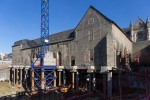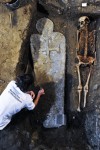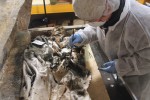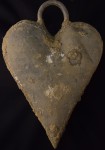The remains of a noblewoman buried at the Convent of the Jacobins in the northwestern French city of Rennes in 1656 have been found in exceptional condition. Discovered in March of 2014, the remains have been quietly studied by a multidisciplinary team who are now revealing the results of their investigations.
 The 14th century Convent of the Jacobins site was thoroughly excavated by archaeologists from France’s National Institute for Preventive Archaeological Research (INRAP) before construction of a convention center would damage the archaeological record. The location was known to have been inhabited from the 1st century when it was the intersection of four major roads just outside the Gallo-Roman city of Condate. It was left to its own devices in the 4th century when the city contracted to the 3rd century walls for protection against marauders. It wasn’t until the 14th century that the area came back to prominence with the construction of a Dominican convent on the site.
The 14th century Convent of the Jacobins site was thoroughly excavated by archaeologists from France’s National Institute for Preventive Archaeological Research (INRAP) before construction of a convention center would damage the archaeological record. The location was known to have been inhabited from the 1st century when it was the intersection of four major roads just outside the Gallo-Roman city of Condate. It was left to its own devices in the 4th century when the city contracted to the 3rd century walls for protection against marauders. It wasn’t until the 14th century that the area came back to prominence with the construction of a Dominican convent on the site.
The convent was built in 1369, funded by a local burger but officially founded by John IV of Montfort, Duke of Brittany, after his final defeat of Charles of Blois at the Battle of Auray (September 29th, 1364) in the War of the Breton Succession. In the 15th century a painting on wood of the Madonna and Child known as Our Lady of Good News became a popular object of veneration and as a result, the convent grew into a major draw for pilgrims and preachers. Because of the painting, the convent became known as the Convent of the Good News. It also played a significant political role. It was at the Convent of the Jacobins that the 14-year-old Anne of Brittany was engaged, under extreme duress, to King Charles VIII of France two days after Rennes fell to his besieging army in November of 1491.
 For the next 300 years, the convent served as an important burial ground not just for the religious who called it home, but for the devout who wished to be buried in the shadow of Our Lady of Good News. It all came to an end in 1793 when the Convent of the Jacobins was claimed by the French Revolutionary Army which had expanded geometrically early in the year with the introduction of recruitment quotas and then mass conscription by the summer. They used it as barracks and sports club off an on for more than two centuries, finally selling it to the city of Rennes in 2002. It has been unoccupied and unused since then.
For the next 300 years, the convent served as an important burial ground not just for the religious who called it home, but for the devout who wished to be buried in the shadow of Our Lady of Good News. It all came to an end in 1793 when the Convent of the Jacobins was claimed by the French Revolutionary Army which had expanded geometrically early in the year with the introduction of recruitment quotas and then mass conscription by the summer. They used it as barracks and sports club off an on for more than two centuries, finally selling it to the city of Rennes in 2002. It has been unoccupied and unused since then.
After the city decided to restore the convent’s historical buildings and integrate them into a contemporary space that will include two auditoriums and underground convention rooms beneath the medieval foundations, INRAP was called in to excavate the site starting in 2011. They found evidence of its Roman life (road remains and artifacts dating to the 1st century A.D. when there was a small shrine which by the 3rd century was a full-on temple surrounded by large townhouses), medieval masonry and more than 800 burials, mainly in the chapter room.
 Out of those 800 burials, five were in lead coffins, an indication of the wealth and prestige of the deceased. Four of them were found in the church choir, and their remains, while skeletonized, were in good enough condition to show the tell-tale marks of embalming, a funerary practice reserved for the elite in the 17th century. The fifth lead coffin was unearthed at the base of a wall of the Chapel of St. Joseph. As soon as the archaeologists opened it, they saw it was completely different from the other four.
Out of those 800 burials, five were in lead coffins, an indication of the wealth and prestige of the deceased. Four of them were found in the church choir, and their remains, while skeletonized, were in good enough condition to show the tell-tale marks of embalming, a funerary practice reserved for the elite in the 17th century. The fifth lead coffin was unearthed at the base of a wall of the Chapel of St. Joseph. As soon as the archaeologists opened it, they saw it was completely different from the other four.
“We saw right away that there was a lot of volume, fabric, shoes,” said Rozenn Colleter, an archaeologist at the French national institute for preventive archaeological research.
Colleter also said that beneath the cape, archaeologists could distinguish “hands that were holding a crucifix”.
 To discover what they could about the deceased, archaeologists enlisted the aid of experts at the University Hospital of Toulouse. They had to act quickly, like within 72 hours after opening, because after 350 years protected in a lead coffin, the remains were in grave danger from environmental conditions and insects. The body was scanned and X-rayed and a virtually autopsy was performed. She was a woman of about 60 years old at the time of her death. Lesions in the lungs indicate she died from a respiratory infection like pneumonia or most likely tuberculosis. She also had kidney stones. The mummification was natural.
To discover what they could about the deceased, archaeologists enlisted the aid of experts at the University Hospital of Toulouse. They had to act quickly, like within 72 hours after opening, because after 350 years protected in a lead coffin, the remains were in grave danger from environmental conditions and insects. The body was scanned and X-rayed and a virtually autopsy was performed. She was a woman of about 60 years old at the time of her death. Lesions in the lungs indicate she died from a respiratory infection like pneumonia or most likely tuberculosis. She also had kidney stones. The mummification was natural.
 She was buried wearing a multi-layer religious habit: a cape, chasuble, a brown gown of coarse wool twill, a linen shirt, wool leggings or stockings, a devotional scapular wrapped around her right arm and leather mules with cork soles on her feet. Her face was covered by a shroud and her head was covered by two bonnets and a cap held in place by a headband. This is an exceptional find. Complete habits from the 17th century, the fabric still supple, don’t crop up very often.
She was buried wearing a multi-layer religious habit: a cape, chasuble, a brown gown of coarse wool twill, a linen shirt, wool leggings or stockings, a devotional scapular wrapped around her right arm and leather mules with cork soles on her feet. Her face was covered by a shroud and her head was covered by two bonnets and a cap held in place by a headband. This is an exceptional find. Complete habits from the 17th century, the fabric still supple, don’t crop up very often.
 The woman was not, however, a nun, not for most of her life, anyway. We know this because her husband’s heart told us so. All five of the lead coffins were found with lead heart-shaped containers next to their heads. Each of them held a heart, some wrapped in fabric and plant matter, probably embalming plants. Four of the hearts were engraved, including the one next to our well-preserved lady. It was inscribed “This is the heart of Toussaint de Perrien, knight of Brefeillac, whose body lies at the Savior near Carhay in the convent of the Discalced Carmelites that he founded and died at Rennes the 30th of August, 1649.” Documentary research found a reference to one Louise de Quengo, Lady of Brefeillac, who died in 1656 and was buried in St. Joseph Chapel next to the heart of her husband.
The woman was not, however, a nun, not for most of her life, anyway. We know this because her husband’s heart told us so. All five of the lead coffins were found with lead heart-shaped containers next to their heads. Each of them held a heart, some wrapped in fabric and plant matter, probably embalming plants. Four of the hearts were engraved, including the one next to our well-preserved lady. It was inscribed “This is the heart of Toussaint de Perrien, knight of Brefeillac, whose body lies at the Savior near Carhay in the convent of the Discalced Carmelites that he founded and died at Rennes the 30th of August, 1649.” Documentary research found a reference to one Louise de Quengo, Lady of Brefeillac, who died in 1656 and was buried in St. Joseph Chapel next to the heart of her husband.
 The removal of hearts and burials in multiple locations were a common practice among the elite of medieval, Renaissance and early modern France. Indeed, Louise herself is missing her heart. It was removed before burial — the ligatures in her chest testify to this posthumous operation having been performed by a highly skilled surgeon — and was likely buried next to her husband’s body just like his heart was buried next to hers.
The removal of hearts and burials in multiple locations were a common practice among the elite of medieval, Renaissance and early modern France. Indeed, Louise herself is missing her heart. It was removed before burial — the ligatures in her chest testify to this posthumous operation having been performed by a highly skilled surgeon — and was likely buried next to her husband’s body just like his heart was buried next to hers.
It was also fairly common for noble widows to retire to a convent. That would explain why Louise was buried in a habit. Even if she never took the vows, she may have given the convent a large donation and been buried in religious garb as an honorific.
 The garments are being cleaned and conserved. They were acquired by the Museum of Brittany and will go on public display. When the investigation is complete, Louise de Quengo’s remains, currently in a freezer in Toulouse, will be reinterred in the North Cemetery in Rennes.
The garments are being cleaned and conserved. They were acquired by the Museum of Brittany and will go on public display. When the investigation is complete, Louise de Quengo’s remains, currently in a freezer in Toulouse, will be reinterred in the North Cemetery in Rennes.
The French language video on this page has excellent footage of the convent excavation and of Louise’s remains.